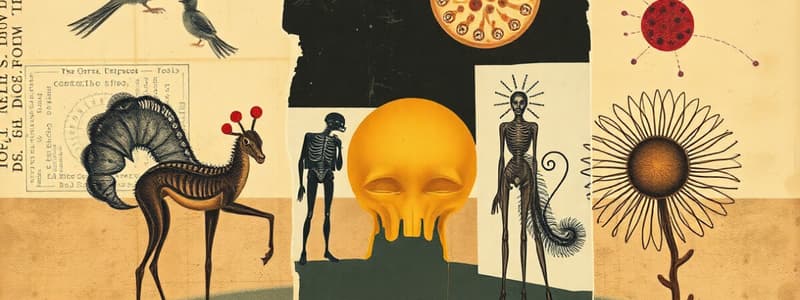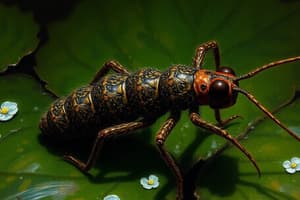Podcast
Questions and Answers
Which of the following organisms are classified as prokaryotes?
Which of the following organisms are classified as prokaryotes?
- Plants
- Fungi
- Bacteria (correct)
- Animals
What is the primary method through which plants obtain their energy?
What is the primary method through which plants obtain their energy?
- Consuming other organisms
- Photosynthesis (correct)
- Decomposing organic matter
- Chemosynthesis
What type of organisms can be classified as eukaryotes?
What type of organisms can be classified as eukaryotes?
- Fungi and viruses
- Animals, plants, fungi, and protists (correct)
- Only animals
- Plants and bacteria
Which characteristic is common among all fungi?
Which characteristic is common among all fungi?
Which statement correctly describes a distinguishing feature of viruses?
Which statement correctly describes a distinguishing feature of viruses?
What ecological role do most bacteria play?
What ecological role do most bacteria play?
What is the estimated number of animal species on Earth?
What is the estimated number of animal species on Earth?
Which of the following is a feature of protists?
Which of the following is a feature of protists?
Flashcards
Kingdoms of Life
Kingdoms of Life
The five kingdoms of life are: Animals, Plants, Fungi, Protists and Bacteria.
Viruses: Non-Living
Viruses: Non-Living
Viruses are non-living particles that can only reproduce inside a living cell.
Eukaryotes: Cell Structure
Eukaryotes: Cell Structure
Eukaryotes are organisms whose cells have a nucleus containing DNA.
Prokaryotes: Cell Structure
Prokaryotes: Cell Structure
Signup and view all the flashcards
Animals: Key Features
Animals: Key Features
Signup and view all the flashcards
Plants: Key Features
Plants: Key Features
Signup and view all the flashcards
Fungi: Key Features
Fungi: Key Features
Signup and view all the flashcards
Protists: Key Features
Protists: Key Features
Signup and view all the flashcards
Study Notes
Kingdoms of Life
- Five kingdoms of life: animals, plants, fungi, protists, and bacteria
- Viruses are not considered living organisms, they're not part of any kingdoms
- Eukaryotes: animals, plants, fungi, and protists
- Have eukaryotic cells with DNA in chromosomes within a nucleus
- Larger than prokaryotic cells
- Prokaryotes: bacteria
- Don't have a nucleus, DNA is loose in the cell
- Smaller than eukaryotic cells
Animals
- Estimated 5-10 million different species
- Multicellular organisms
- Heterotrophs: obtain energy by consuming other organisms
- Most reproduce sexually
Plants
- Estimated 300,000 species
- Multicellular organisms
- Autotrophs: obtain energy from sunlight through photosynthesis
Fungi
- Can be multicellular (e.g. mushrooms) or unicellular (e.g. yeast)
- Heterotrophs: obtain energy from other organisms
- Saprotrophs: feed by secreting digestive enzymes onto food, breaking it down, and absorbing nutrients
- Multicellular fungi have a body called a mycelium made up of thread-like structures called hyphae
- Some fungi can be pathogens, causing disease (e.g., athlete's foot)
Protists
- Also known as Protista, Protists, or Protozoa
- Mostly unicellular organisms
- Diversity in energy acquisition: some photosynthesize (e.g. chlorella, euglena) like plants, others consume other organisms (e.g. amoeba) like animals
- Some can be pathogens (e.g., Plasmodium causing malaria)
Bacteria
- Single-celled organisms
- Found in various environments, including on skin and in intestines
- Some can photosynthesize, but none have chloroplasts
- Most obtain energy from consuming other organisms (living or dead)
- Estimated to be more species of bacteria than all other kingdoms combined
- Some cause disease (e.g., salmonella causing food poisoning), but many are beneficial (e.g., gut bacteria aiding digestion)
Viruses
- Non-living particles, much smaller than bacteria
- Structure: protein coat surrounding genetic material (DNA or RNA)
- Can only reproduce inside living cells, acting as parasites
- Always considered pathogens
- Infect various organisms, including animals, plants, bacteria, and protists
- Examples: influenza virus, tobacco mosaic virus, HIV, COVID-19
Studying That Suits You
Use AI to generate personalized quizzes and flashcards to suit your learning preferences.




